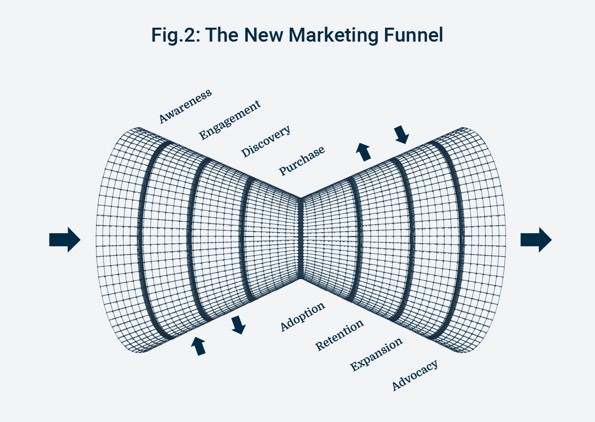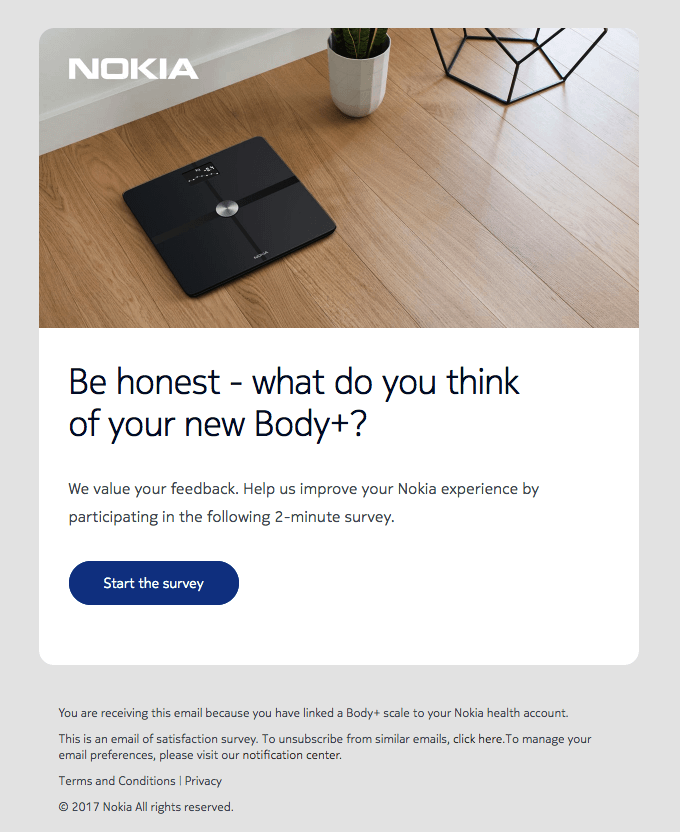Article first published February 2018, updated July 2019
You’ve heard it a thousand times: Marketing is all about attracting potential customers to your business.
As marketers, we love to talk about the tactics we use to do our jobs. We write articles, gather at Meetups, and organize conferences to discuss topics like branding, SEO, media buying, display advertising, branded content, and much more.
However, what happens after a prospect becomes a customer is rarely discussed. Sometimes marketers feel like it’s their job to bring people to the business, not make them come back after their purchase. This can be a big mistake.
Think of marketing as a funnel where you attract a wide net of people to your website and slowly incentivize them to become more interested in your offerings. With this model in mind, marketing represents only the beginning of the funnel, the “top of the funnel” as it’s known.
There’s something more important that happens at the end of the funnel (i.e. after someone make a purchase), and what happens can help you increase your revenue substantially. It’s called retention.
Read on to learn why you should focus on customer retention to grow your business.
What is retention?
The act of making customers “come back again and again” is retention. Retention is a group of marketing tactics you use to bring people back to your company. Just as you use tactics to acquire customers, you use tactics to keep them engaged. Since retention begins after a purchase, marketers need to reframe the way they think about serving their customers.
In a this article about the future of email marketing, Samantha Anderl said the standard marketing funnel no longer exists. Focusing only on acquisition won’t do it anymore. There are more things to a marketing funnel than acquisition.
A new marketing funnel has emerged and merges pre-purchase and post-purchase stages to present a complete view of the entire customer lifecycle. Multi-channel, multi-touch, multi-path customer journeys are the new marketing funnel.
[…] The end goal is no longer to simply convert a lead into a customer. It’s about maximizing the lifetime value of loyal customers who will come back again and again.

How retention changes the marketing paradigm
Marketing has historically been focused only on tactics to attract more people to a brand.
Retention changes the marketing paradigm: You no longer just look for new potential customers; you focus on making more money from your existing consumers. This is not to say that you should stop doing “traditional” marketing altogether. Instead, you should complement your marketing tactics focused on acquisition with those that focus on retention.
Take search engine optimization (SEO), a classic digital marketing tactic, as an example. SEO focuses on making your website attractive to search engine bots, which can increase your websites position in search results (SERPs), thus attracting more organic traffic to your site.
Every time you publish a new page that you want to rank in the search engines for a given keyword, you need to invest to attract links to it (which are one of the most important ranking factors). Depending on the industry, a link building campaign can cost from $100 to over $10,000.
Contrast that with a retention tactic: email post-purchase automation. As we explain here, using email post-purchase customer journeys helps you bring qualified traffic to your site, people to whom you have already convinced of making business with you. They already know you, and if you did a good job with your first sale, they probably already trust you, too.
The cost of such a campaign would be low. You need to compute the creation of the emails: copy, design, timing, and the cost of the email marketing provider.
The pricing delta between an acquisition campaign and a retention one can be high. What’s more, the ROI of the latter can be much higher than the former, as you are targeting people who already know your brand.
According to the book Marketing Metrics, selling to a new prospect has an average profitability that ranges between 5% – 20%, while one that targets an existing customer ranges between 60% – 70%. In other words, it’s more than 350% more profitable to sell to an existing customer than to a new one.
But retention is more than sending an email: It’s also about personalizing their shopping experience. If someone buys a product, they likely want more products related to it, at a similar price range, targeted to their own demographics.
By focusing on retention, you can increase the rate of a customer purchasing again, as well as increasing the order frequency and the average order value of each repeat purchase. This, in turn, increases the customer lifetime value (CLV) as well as your long-term profitability.
Retention tactics you can use
Back in the day, a company could only hope that their customers would come back. The one-on-one attention they could provide and the way the business owner knew what their customers wanted helped them create a more personalized experience, which in turn drove retention.
While the online world provides countless opportunities—more selection, better prices, and convenience, among others—it also creates friction in the shopping experience. You no longer know what each specific customer wants and likes.
With the help of technologies like big data and AI, you can discover what people buy, and based on that, recommend possible purchases which drive the retention up.
You have many options available that you can use to get started with retention. To illustrate what I mean, take a look at the following stats:
- According to a whitepaper done by Emarsys, 80% of businesses surveyed relied on email marketing for customer retention.
- The same study found 44% U.S. retail professionals said social media drives retention.
- Emarketer did a survey where 56% of marketers considered email marketing to be the most effective method of reaching customer retention goals.
- 37% of U.S. retail professionals have said retargeting drives customer retention, 21% said affiliates drive customer retention, and 18% said referral marketing drives customer retention.
As you can see, there are many tactics you have at your disposal. But if you take these statistics as our main data point to measure future steps, then it’s clear that email marketing is the best.
Whatever tactic you use, remember that retention is part of a bigger customer journey. If you fail to sync your retention strategy with the acquisition one, it may fail to deliver results.
Finally, we suggest you take a look at your analytics and see what works best for you. Use your strengths rather than following some stats. If you or your team have a good grasp of email marketing, get started with it. Otherwise, use some of the other tactics described above.
Retention and loyalty
While retention and loyalty have a lot in common, there are some key differences you should know.
Retention measures the frequency in which an existing customer continues to do business with your business, while loyalty measures their predisposition to select your business as their main preference.
In other words, when a customer buys from you a second time, they’ve technically been retained. Still, this doesn’t necessarily mean they’re a loyal customer. Rather than being their favorite store, your business might just offer better pricing or better selection.
Your ultimate goal is to drive retention up while making customers loyal to your brand. Take a look at the previously shown funnel: Only after retention you see expansion and advocacy. Simply put, you want to focus on retention, so you can end up with loyal customers.
Use email marketing to create your cult following
Email marketing is a great tool for building a cult following that will stick with your business for life. It is one of the key tools you can effectively use in your customer retention marketing endeavors. Here are a few ways you can use it to build your cult following:
Make your customers feel welcome from the start
First impressions are always the most important. They determine the final outcome of your relationship with your customer. Customer retention marketing doesn’t start after the sale – it starts with your welcome email series.
Source: Really Good Emails
Let’s take a look at a few factors that can help you win a loyal customer with your welcome email series:
- Timing is everything: Send your initial welcome email immediately after your customer signs up.
- Make it engaging: Infuse your brand personality in your email. Don’t be afraid of injecting a bit of humor.
- Offer a gift: Including a “welcome gift” is certainly a good win to earn your customer’s affection.
When your customer feels welcomed, it becomes easier for them to take the relationship to the next level.
Optimize your onboarding process
Onboarding your customers is a crucial part of building lasting relationships with your customers. Onboarding is the process of taking your customers from being a prospect to a loyal customer and beyond. A good onboarding process involves:
- Building trust in your product: You can achieve this by using testimonials and case studies in your emails.
- Encouraging customer feedback: Check in with your customers regularly to find out if they need help with using your product well. It is this that makes your feedback email an important part of your onboarding process. Use one of our feedback email templates.
- Offer tips and hacks: No one knows your product better than you. Offering your customers tips and hacks to get the best experience with your product is a great way to build a customer retention marketing strategy to create a cult following.
Source: Really Good Emails
Create a memorable customer journey
When it comes to leading your prospect to a sale, you need to create a customer journey that will make a lasting impression on your customer. A great customer journey is a result of:
- Personalization: Everyone is loyal to a business that shows that they care, and creating content that is unique to their interests demonstrates that they are more than just a number in your list.
- Address their pain points: Helping your customers understand their problems is one of the best ways to lead them to the solution – your product. Being clear about this is creates a customer journey that is unforgettable.
A well designed and executed customer journey is a great way of using email to create a cult following
Putting these strategies to work, you can nail your customer retention campaigns easily using email. That, as they say, is why email is king.
Wrap up
Going into the future, marketing will continue to face changes which will challenge its traditions. Now that it’s becoming easier for marketers to make use of technologies such as AI, big data, and machine learning, the way marketing is done will continue to evolve.
Along these technological advances, marketers also need to open their minds and focus on activities that extend beyond customer acquisition. Overlooking the sales funnel and working only on a part of it won’t cut it anymore.
Today and into the future, the new extended funnel will push marketers to work on the other parts of the funnel, the ones where the ROI lies. Retention has become the new marketing.
Looking for more ways to increase your customer retention rates using email? Check out our article on how small businesses can build a cult following through email.







